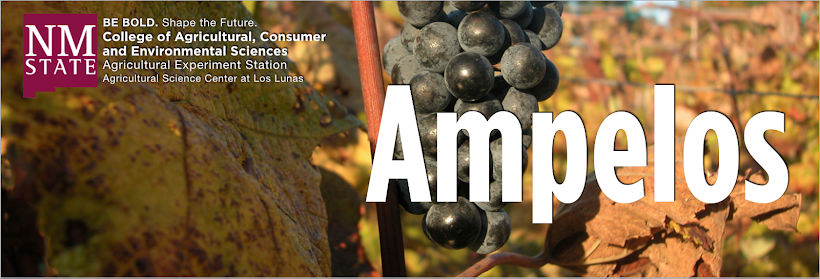Grapevine Petiole Sampling Standard Method
Gill Giese, NMSU
Extension Viticulture Specialist
 |
| Figure 1. Grape shoot with leaf location to obtain the petiole sample |
Figure 1. Left: grape shoot with the 6th leaf from the shoot tip circled in red. In the drawing on the right the petiole is still attached to the leaf blade.
 |
| Figure 2. Grape leaf blade with petiole that is kept, processed and submitted. |
1.
The petiole, or leaf stem, is submitted to the lab for
analysis. Petioles are ideal to handle and store. They do not breakdown/mold as
readily as do leaf blades. Petioles are convenient to dry and ship.
2.
At collection, break off the petiole where it attaches
to the stem/shoot. Immediately separate the petiole from the leaf blade to
prevent translocation of sap from petiole into leaf blade. Discard leaf blade.
3.
Timing and location: select and collect petioles attached to the leaf
opposite a fruit cluster at full bloom. Grapevines are judged to be in
“full bloom” when about 60-75% of flower caps are shed. Use the most recent,
fully mature leaf. Recently mature leaves are typically located at the fifth to seventh node counting from the
shoot tip (refer to Figure 1 above).
4.
Collect petiole samples at the same time year to year
and at the same time of day (morning preferred).
5.
There is no one “best” time to collect petiole
samples, as there is no single time that is diagnostic for all possible
nutrient disorders and deficiencies. However, nitrate peaks in most grape
varieties at bloom and nitrogen is the nutrient most often deficient and most
frequently applied. Also, testing for nitrogen in the soil yields less than
robust results due the fact that nitrogen is very mobile within and readily
leaches from the soil. Consequently, testing for soil nitrogen will indicate
different amounts of N at different times of year.
a.
Potassium levels decline from bloom to veraison, when grape berries begin to
soften, develop sweetness and change color.
b.
Boron, if low at bloom, can recover as temperatures
warm late in the season.
c.
In some regions, i.e. France, California and Oregon, the
most recently fully developed leaf is sometimes collected in August and used
for analysis.
6.
If possible, avoid sampling vines on border rows or
adjacent to dusty roads.
7.
Gently wash freshly collected petioles with mild
detergent water bath (Dreft baby detergent is often used or a detergent that
does not contain phosphorous). Transfer petioles to a water rinse and then
finish with a final rinse using distilled water. Rinsing is intended to remove
dust and/or chemical spray residue. Finally, transfer the washed and rinsed
petioles to paper towels to dry. After the petioles are completely dry…place the
dried petioles in a paper bag, allow
to dry in the open bag for a few days prior to shipment to the lab.
8.
Collect separate samples by cultivar and block.
9.
Collect 1-2 petioles per vine. The total sample should
contain 50-100 petioles
10. Alternately, collect 5-10 petioles from 10-20
representative vines and flag these for
small fertilizer trials or repeat
samples.
11. If you apply nutrients or want to track what
is going on in the vineyard over the season,
a 2nd petiole sample can be
collected at 70-100 days post-bloom, at veraison
(see description of veraison above).
Table 1. Target values for soil, bloom petiole and
late summer petiole samplings. THE
TARGET VALUES IN THE TABLE ARE GENERATED FROM GRAPE REGIONS OUTSIDE OF NEW
MEXICO AND ARE PROVIDED AS ESTIMATES ONLY!
|
|
|
|
Late-summer petiole |
|||
|
Nitrogen |
—z |
— |
1.2 - 2.2 |
% |
0.8 - 1.2 |
% |
|
Phosphorus |
20 - 50 |
ppm |
0.17 - 0.30 |
% |
0.14 - 0.30 |
% |
|
Potassium |
75-100 |
ppm |
1.5 - 2.5 |
% |
1.2 - 2.0 |
% |
|
Calcium |
*500 - 2000 |
ppm |
1.0 - 3.0 |
% |
1.0 - 2.0 |
% |
|
Magnesium |
100 - 250 |
ppm |
0.3 - 0.5 |
% |
0.35 - 0.75 |
% |
|
Boron |
0.3 - 2.0 |
ppm |
25 - 50 |
ppm |
25 - 50 |
ppm |
|
Iron |
20 |
ppm |
30 - 100 |
ppm |
30 - 100 |
ppm |
|
Manganese |
20 |
ppm |
25 - 1000 |
ppm |
100 - 1500 |
ppm |
|
Copper |
0.5 |
ppm |
5-15 |
ppm |
5 - 15 |
ppm |
|
Zinc |
2 |
ppm |
30-60 |
ppm |
30 - 60 |
ppm |
References:
1. Kamas, J. 2014. Growing Grapes in Texas, Texas A&M
University Press, College Station, Texas.
2. Wolf, T.K. editor. 2008.
Wine Grape Production Guide for Eastern North America. NRAES, Cooperative
Extension Ithaca, NY.
Labs:
1. Waypoint Analytical: http://waypointanalytical.com/PlantTissues
2. Fruit Growers Lab: http://www.fglinc.com
3. A&L Labs Lubbock,
TX: http://al-labs-plains.com/
